Every picture tells a story: Photographers discuss the best news photos of 2015
In this gallery, Reuters photographers tell the story behind some the most memorable and powerful images of 2015, a year dominated by terror attacks in Paris, the Syrian civil war and refugees' perilous journeys across the Mediterranean towards western Europe.
Reuters photographer Stephane Mahe, who took this photo after the Charlie Hebdo shootings, says: "I covered the arrival of the heads of state at the start of the solidarity march. I then made my way through the streets, which were packed with people holding Je suis Charlie banners, to the Place de la Nation. It was the end of the day, the light was soft as I walked around the statue The Triumph of the Republic, looking for a picture with the French flag and a pencil.
"I was fortunate that everything fell into my frame and I was able to combine dramatic light, a dynamic gesture with the giant pencil, and an interesting group around the statue. People online have called it The Pencil Leading The People, in reference to the famous painting by Eugene Delacroix, Liberty Leading the People. I find the comparison really interesting and it was a historic march, but I am surprised that my photograph has become so symbolic of the day."
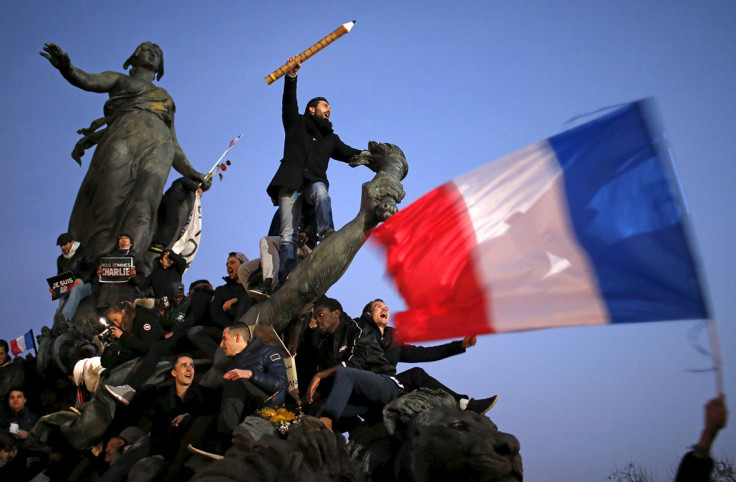
Gleb Garanich: "I was with the Reuters TV crew and we were coming back from the frontline in Debaltseve when a crew member saw a tweet saying Kramatorsk was being shelled, so we headed there. We got to the site of the shelling less than an hour after the explosion. The first thing we saw was a dead woman's body lying on the ground; she had been like that for at least half an hour. The locals were just walking by, hardly reacting to what was going on. Someone later came by and brought a cloth to cover her body. Her husband then showed up. He had been looking for her, calling home, but he could not find her.
"He went home and did not find her there either, that is when he made his way to where we were and saw her on the ground. He was frantically looking for a way to take her body away. He was looking for an ambulance, a police car, anybody who would be able to take her body. We were there for 45 minutes and for the first half hour we experienced no trouble at all from either locals or officials but later it became challenging. The people there can be aggressive towards journalists.
"This happens practically everywhere, especially where there is shelling or shooting. Wherever people are underground, without food, they get angry. I find it challenging to cover a war in my own country. I was born in Russia; my wife is from western Ukraine. My children speak both languages. I would have never imagined that one day there would be a war here."
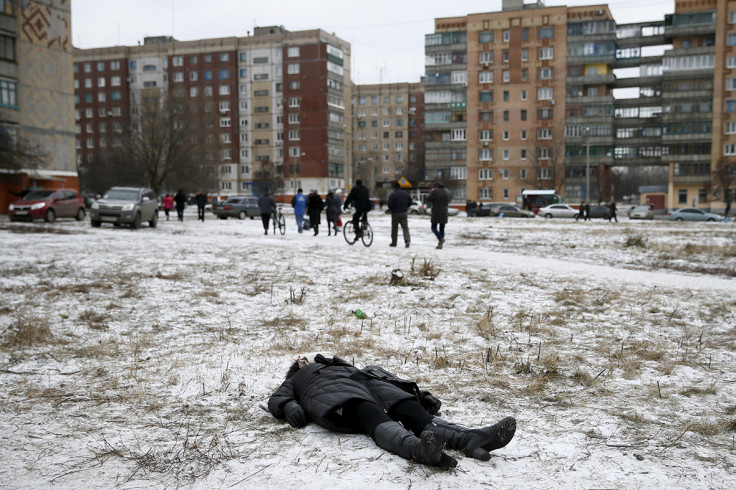
Emmanuel Braun: "I was covering the Chad army offensive inside Nigeria against the insurgent group Boko Haram when I shot this picture. It shows a prisoner, believed to belong to Boko Haram, caught during the ride we had with the Chadian troops on the battlefield. Most Boko Haram fighters had left but few isolated ones were caught that day.
"The man was accused of killing five people the way Boko Haram does, cutting their throat with a knife. That is why one of the soldiers gave him a nickname The Butcher. A Chadian soldier told me: 'Come and see this guy, he killed five cutting their throat and he's not even denying it.' He symbolised all the horror and fear behind Boko Haram. The soldiers violently dragged the prisoner to expose him to the press. The challenge with this picture was being fast enough to shoot it before the other journalists could show up and make it impossible. I think it is a strong picture because of the brutality that emanates from the scene. The soldier presents the prisoner like you do with an animal at a fair."

Bassam Khabieh: "I was covering the Syrian Arab Red Crescent convoy's visit to the Douma neighbourhood of Damascus. It was carrying medical aid and supplies used to give psychological support to children affected by war. Every time the aid convoy arrived, children would gather around it, happy that they were going to be supplied with food and medicine. Before the shell landed on the convoy I was sitting on the pavement relaxing; the children gathered around me so I could photograph them.
"While I was taking these photos, the shell exploded. It killed a female volunteer and wounded many people and volunteers nearby. The children were terrified and began to scream and cry, especially when they saw a female volunteer covered with blood from a head injury. The challenge to portray this image was just like the challenges we face daily in time of war. I knew that there might be another shell falling within a matter of seconds; then one did exactly that a little further away. Do you want to protect yourself, like everyone else, by walking into a shop or home? Help carry the injured or be satisfied to take photos while others transfer them to ambulances? Do you want to calm screaming children? Or do you just want to cry because of what has happened?
"All these questions need answers in a matter of seconds before you can capture such an image. In this particular photograph, it was the first time I had seen how children's innocent laughter could turn into screams, fear and tears. It was a very sad moment when I put my eye to the viewfinder to take pictures of laughing children; then when I looked back after taking the picture, I saw the same children crying, distraught. It takes only a few seconds for life to turn to ashes and blood."
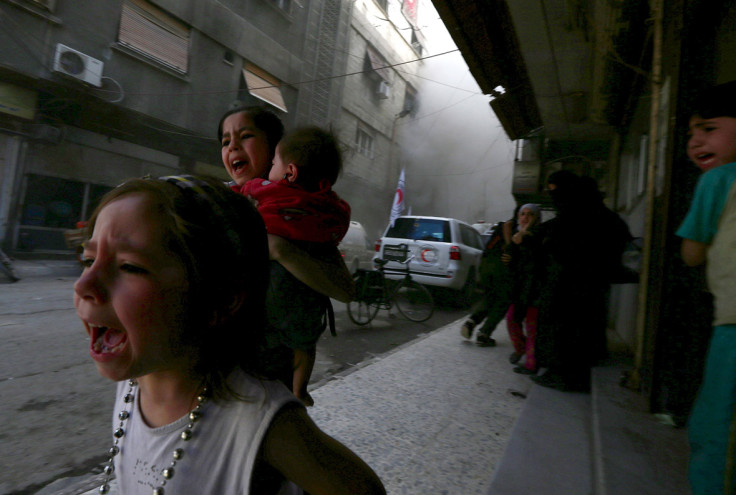
Goran Tomasevic: "Protesters started throwing stones at a group of police, who then started to run away. The policewoman in the photo, Medikintos Inabeza, 33, got left behind and then some protesters started to push her, saying that she had shot a female protester in the stomach with an AK47 rifle. I didn't see anything of that.
"There were five or 10 protesters pushing the policewoman at first, then others came and joined in. Up to 20 or 30 protesters were surrounding her at one point. The protesters kicked and beat her very badly; I also saw a couple of knives. I thought they were going to kill her. The people attacking her were really aggressive. What was really surprising to me was that the other police abandoned her when the stones were thrown. Maybe some were initially too scared to help, other than the two policemen who were doing what they could to rescue her. There was even one protester who tried to protect the policewoman.
"The whole thing lasted 20 or 30 minutes. It ended when, for some reason that was hard to figure out, the protesters let her go, handing her over to another group of police further on. I was the only photographer there when this incident happened. I've been in situations with angry crowds before but I've never seen something like this. Pictures sometimes tell a bigger story than words. This was one of those occasions."
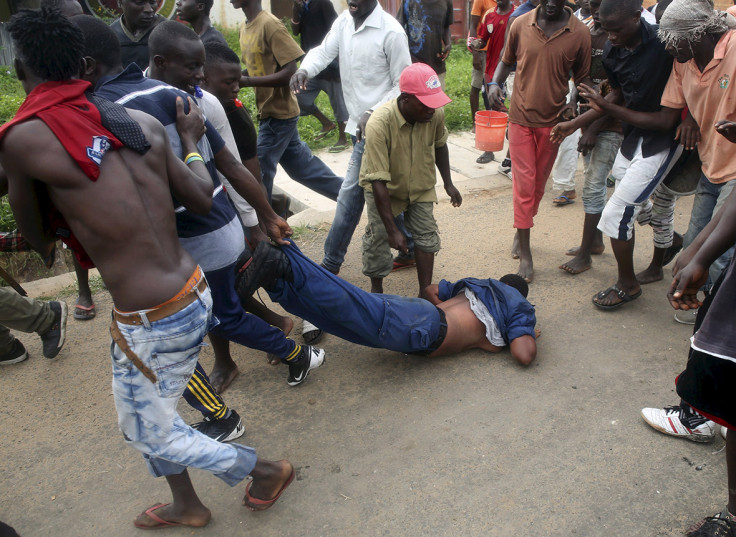
Soe Zeya Tun: "This shot is of a group of Rohingya and Bangladeshi migrants who were rescued from a boat carrying 734 people off Myanmar's southern coast. Those on board had been at sea for more than two months - at the end with little food or water. The men in this photo were part of a group of 400 crammed into a warehouse by Myanmar police. They had arrived the day before, but while the women, children and some men had already been moved, these men were left behind.
"There was no sign of the UN refugee agency UNHCR or foreign aid agencies. Just moments before this shot, the sky opened and the monsoon rains started coming down. The men were jostling with each other for space to catch water in their bottles and plates. The authorities were hesitant to grant us access at first, but as the morning wore on and the rains started, we were able to enter and start photographing and speaking to migrants.
"Just after taking this photo, the men were loaded into buses and trucks and driven to a camp where international aid agencies were waiting. I have worked on long and difficult assignments where I have gone days without a proper shower. But for these people it had been months without enough water. Everyone was dirty and had likely washed little while at sea. I could see just how meaningful it was for them to suddenly have a chance to drink and clean themselves with whatever small amount of water they could capture."
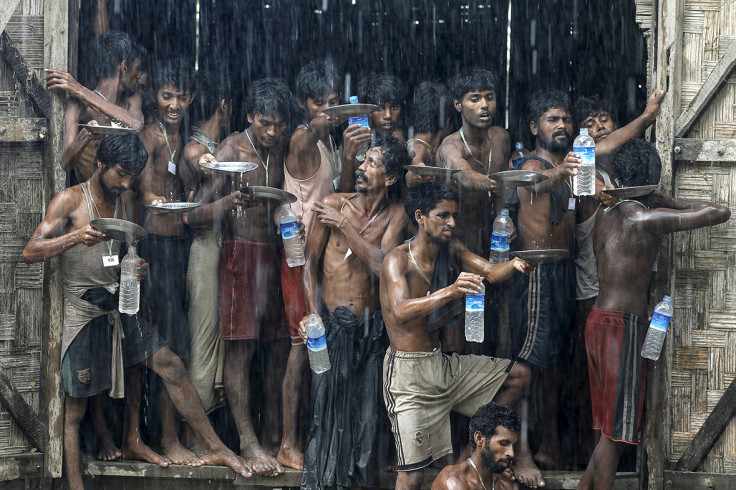
Beso Gulashvili: "The flood killed at least 12 people and partly destroyed Tbilisi Zoo, killing dozens of animals, while 30 more – including tigers, lions and bears – managed to escape from their cages. Among the escapees roaming the streets were a rare breed of white lion cub and six wolves, which roamed through the grounds of a children's hospital. The zoo is right in the centre of the city, between the state broadcaster and Tbilisi State University. Heavy rains had turned the Vere river that flows near the zoo and through Tbilisi into a torrent that washed away buildings, roads and cars.
"The enormous amount of mud and debris under my feet meant that making even a small movement was very difficult while shooting photos. I was there from 11.30pm. This photo was shot at 6am the next morning; my memory card was almost full so I had only a couple of shots left. This situation was totally different from any I'd experienced before as a photographer. In the past all my reporting experience had been negotiating with people; this was the first time I worked with animals.
"I was smiling as I took this photo of Begi, as I discovered the hippo was called. I had bought a watch for my 14-year-old daughter in that shop just two days before the flood. And here was a hippo in front of it. There was only one complicated escape route available to me in case Begi decided to attack. There were very few people around, as police had shut down the area. The distance between the hippo and me was about 25m but I realised that even for an animal as powerful as this one it was also quite difficult to move forward in such mud. I was also reassured that armed police would protect me in case of attack. Today, Begi is arguably the world's most famous hippo."
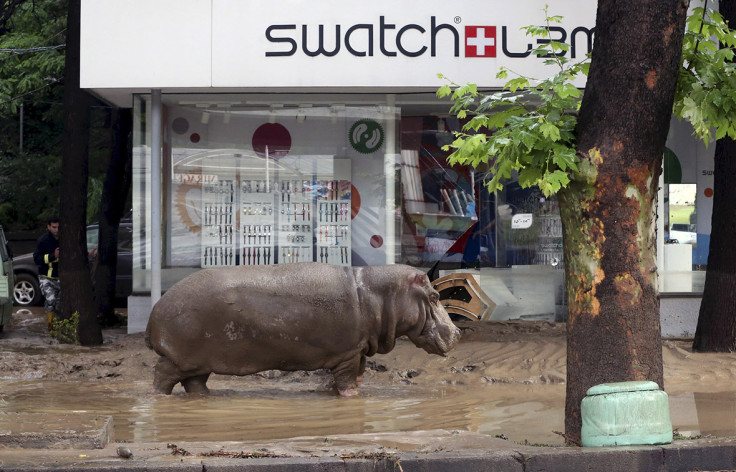
Carlos Barria: "For more than a decade, the United States and other world powers have participated in talks to reach an agreement on Iran's nuclear programme. They and Iran have spent thousands of hours around a table seeking a solution to what the West sees as a threat to global stability if Iran gains the capability to make a nuclear bomb. The last chapter was in Vienna, where I travelled with Secretary of State John Kerry. The media had virtually no access to the meetings, but could register for photo shoots of a minute or two per day.
"For 19 days I sat in a media tent near the hotel where the meetings were held, waiting. The biggest challenge in such tightly controlled environments is to capture a different picture every day. Not least as it was exactly the same situation each time: people sitting around a table talking. I always planned ahead for the next time to capture something new. On 14 July, foreign ministers of the US, Iran, China, Russia, Britain, Germany, France and the European Union walked on stage to tell the world about a historic agreement. Hundreds of journalists from every corner of the planet gathered at the United Nations building for the group photo and press conference.
"As the ceremony ended and colleagues rushed to file their images and stories, I decided to stay on. A few seconds after the country representatives left the stage, a staff member showed up to remove the countries' flags. I ran to the front of the now empty room and waited for the last two flags to be removed. The man took hold of the Iranian flag and walked past the US flag. That was what I had been waiting for: beyond the spotlight, unscripted. When I realised that I was alone, I also knew I had an important picture that no one else had. The lesson: be the first to arrive and the last to leave."
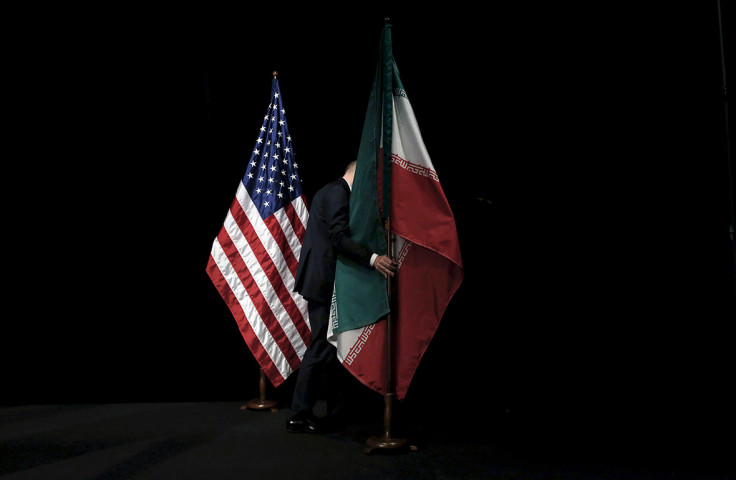
Umit Bektas: "The man in the picture was gesturing to all of us on the other side of the barbed wire, asking the soldiers, officials and media for help. He was far from the only one: countless people were begging to be let across the border. These refugees had rushed from the town of Tel Abyad because they were expecting fighting between Isis and Kurdish forces. 'Take us in, we're dying here,' I heard someone say.
"The baby girl in his arms looked terrified. She was so young but there was something in her eyes – it seemed like she knew what was going on. She wasn't crying, even though she was hanging on to the barbed wire, in spite of the heat, the shouting and chaos around her. There she was with her big eyes, looking out. It appeared to me that she was in shock.
"A few minutes after I took this photo the Turkish officials and military allowed these people to cross the border into Turkey. They arrived dehydrated, desperate to drink water and cool down. There was a complete lack of facilities: no water, no toilets, no shade, no buildings at all. When I captured this image it was midday and the heat was intense, at more than 30C. NGOs and soldiers had started to throw bottles of water across but it was obvious that there wasn't enough to go round. There are tens of thousands of children who are suffering like the girl in this image – she is just one of them."
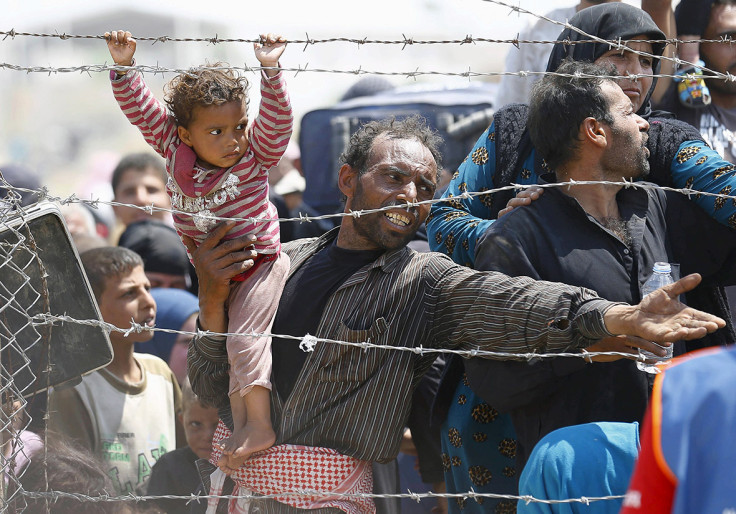
Siphiwe Sibeko: "Some stories have more impact on me than others. This one in my neighbourhood in Johannesburg is a case in point. I got a message that my neighbours' house was being broken into and they needed help. When other neighbours and I arrived, we found one man lying inside the house bleeding. He later confessed that the other robbers had fled and they might still be in the area. There had been an increase in robberies locally.
"A few weeks earlier my car was broken into and all of my photographic equipment stolen in broad daylight. Police patrolling in the neighbourhood helped to apprehend a second suspect. They were both handcuffed outside the house and as we waited there for the arresting officers to arrive, I got out my camera took a few pictures of the suspects handcuffed together. The man who had sustained the gunshot wound was writhing in pain. Both men were crying and pleading with the community not to hit or attack them.
"People in the neighbourhood were angry because burglaries happen all the time even during broad daylight. The other suspects in this break-in have not been found to this day. Although I was both angry and shaken as this robbery took place next to my home, I was able to keep calm as I remembered my responsibilities as a photojournalist not to get carried away by anger and emotions. I have learned always to be calm and have my camera with me at all times. In a country known for violent crime – the murder rate increased around 5% this year from 2014, to nearly 50 every day – home safety is something of an obsession for my family and me. This incident reminded me that, beyond the statistics, crime affects us all in South Africa."

Bernadette Szabo: "Rail tracks, unguarded, line the border with Serbia. Most refugees used the tracks, a few miles long, as a highway into Hungary. I arrived at the border every day at 6am. The crossing was the only spot still not blocked. A triple coil of razor wire was up everywhere else as Hungary prepared to fence off the border. The rail crossing was easy enough but many migrants chose to jump the fence to avoid the police waiting a few hundred metres inside.
"The razors were not too sharp to handle with heavy gloves. Dozens of other photographers and I paced the fence, some way from the rail tracks. Among the shrubs we could make out the contours of migrants waiting for the right moment. Everyone watched everyone else. We watched the refugees, who watched the police, who watched us. It was like an elaborate board game. It was more than just waiting. The people on the other side of the fence filled the atmosphere with strange, unspeakable tension.
"This family decided they had waited enough. They started for the fence. Aware of the stakes, they lifted the razor wire, looked around, then went for it. Once across they vanished in the woods. I never saw them again. Photographing the migrants was the ultimate test of staying out of the story: observe keenly, wait, shoot. Don't cut the wire, don't invite the refugees in, don't alert the police. There was little human contact with the thousands of refugees scaling the fence.
"You learnt nothing about them. They came and went. But those who walked along the tracks stopped and talked. They accepted water or the odd chocolate bar. They even shared stories – stories that will haunt me forever. There is no way to shake the emotional impact. Once I put the camera down and had time to reflect it all came back. You have to let the story wash through you to remain human."

Mohamad Torokman: "It was about an hour after the start of a weekly protest against Jewish settlements in the West Bank village of Nabi Saleh, near Ramallah. Palestinians were scuffling with an Israeli soldier as they tried to prevent him from detaining a boy. The incident happened all of a sudden so I had to rush with my camera to capture this picture.
"The main challenge confronting me was that I should not miss any strong pictures from the scene. I was totally focusing on how to get this picture, without allowing myself to get distracted by anything else. As a photographer you have to be patient until you can capture the strongest image. On any assignment an hour, or even several hours, might go by without an opportunity to get a good picture but then a strong image can emerge all of a sudden. You have to be ready for the opportunity and be able to spot it – to capture the moment that best tells the story in front of you."
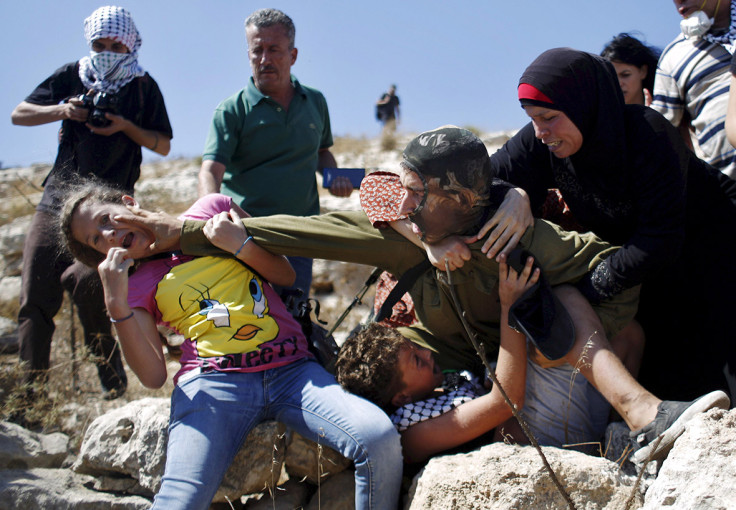
Marko Djurica: "The camerawoman tripped the migrants on purpose. It came as quite a shock when I realised that. Police collected the migrants from the border with Serbia and then the migrants would wait for buses to take them to registration camps. The nearby camp had been full for days so buses didn't arrive. After waiting more than 24 hours, migrants started demanding to leave. There were no more than 50 Hungarian police officers compared with about 1,000 migrants.
"A small group from Syria told me that in 15 minutes the migrants planned to run away and they needed as many journalists around, afraid the police would start beating them. Reuters colleagues and I watched and waited. After 15 minutes, on the command 'Yalla shabab!' ('Let's go!') from someone the migrants ran in all directions. Caught by surprise, the police couldn't stop them. I grabbed my 24-70mm lens, put it on wide open and ran. I saw a man carrying a child running away from a policeman.
"After about 15m, the policeman grabbed him by his jacket; the man started shouting and the kid was crying. After a couple of seconds the young policeman let him go. The man started running again. Suddenly, not more than 5m away, he fell over the child he was carrying. Thankfully they were unhurt. When I edited my pictures, I saw a camerawoman in the frame when he fell. I remember sitting with my phone in a hotel in Szeged soon afterwards watching a low-quality news video of the same thing from a different angle. I realised I had the whole tripping sequence on my laptop. It became a huge story that lasted for days, with pictures published everywhere. Reuters was the only one that had still images of that moment."
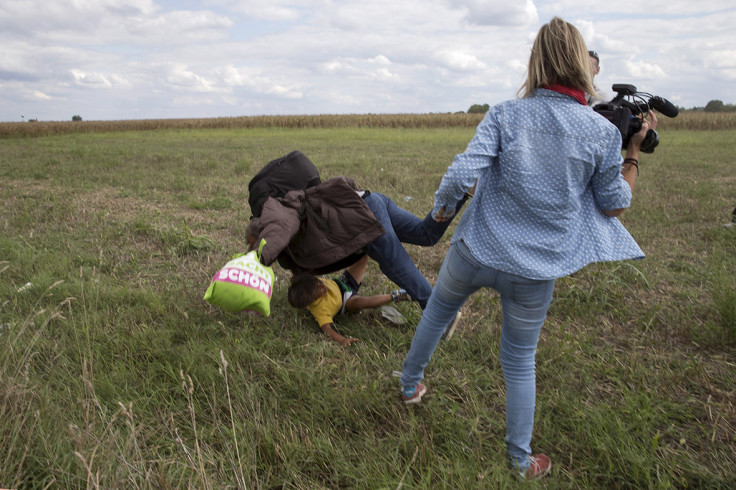
Alkis Konstantinidis: "Another inflatable boat packed with dozens of migrants and refugees heading towards the shore. That's what I noticed in the distance. The sea was calm and they were cheering on the dinghy. Suddenly, some 200m away, the rear of the boat deflated for no obvious reason, and people started falling into the sea. Screams replaced cheers as they frantically tried to stay afloat on life tubes, or by clinging on to the boat.
"Those who could swim tried to help those who couldn't. As this dramatic scene unfolded and people drifted away from each other, the biggest challenge was to capture as many of the different scenes as I could. There were people falling overboard; two men trying to keep their friend afloat; a man still on the boat lifting his child in the air; another man, nearing collapse from exhaustion, swimming towards the shore; volunteers rushing towards the boat.
"In this hectic moment, one man, tense and yelling really loudly, caught my eye so I shot some frames. Later, as he tried to catch his breath on the beach, I asked him where he was from. 'Syria,' he told me before heading towards a volunteer holding a baby. The distance of the shot hadn't allowed me to see the details of the picture clearly. It was only when I began editing that I could make out the tiny head of a baby in a life tube, and the screaming man trying to keep himself and the baby above water.
"Everything I cover, from riots to politics and sports, trains me to be on the alert and try to get the best from what I am shooting. I learned from this experience that disaster can occur even in what appears to be the calmest of situations. Looking back, the most memorable moment was when I opened the picture and saw the baby, who looked fast asleep as if in a cradle – dreaming or listening to a lullaby."
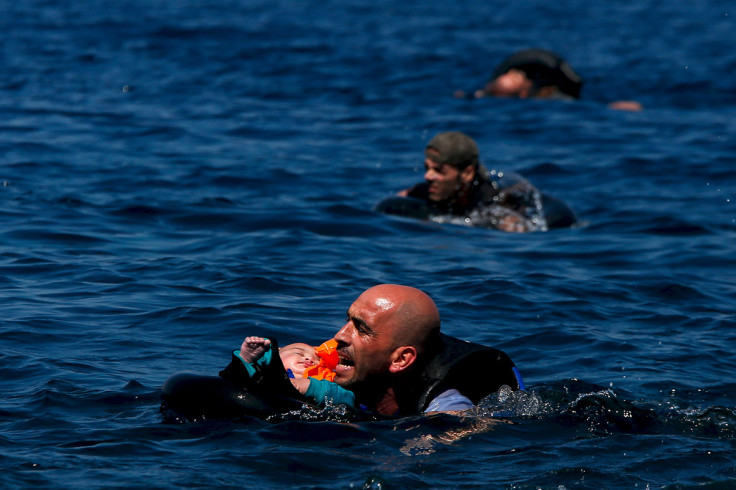
Mussa Qawasma: "I have seen people getting shot and killed. But this was especially terrifying because it was so violent. A Palestinian vehicle ran over and killed an Israeli motorist. The Israeli driver had been using a club to hit Palestinian protesters and cars on a roadside in the Israeli-occupied West Bank. Israeli police said the man had stopped his car and got out after stones were thrown at it. The driver of the Palestinian vehicle, which the Israeli had hit with his club, later turned himself in. Israeli police said it was not clear if the Israeli had been run over deliberately.
"Amid the tension, fear and danger, I remember breathing slowly to control my nerves. I was taking photos of everything – the stone throwing at the Israeli cars, the reaction of the settler with his club, especially when the truck ran him over. I did not think about stopping even if what was happening was unbelievable and shocking. As a photographer I never expected to take a picture of someone being dragged and crushed under a truck's wheels. What happened was so unnerving because the settler was killed in this way.
"Capturing a moment that will never happen again is the hard core of photojournalism. Despite the shocking moment I was lucky to keep control of my mind and do my job as a photographer: to tell the story. What I had learnt from previous experience served me well that day. Firstly don't think about what is happening in front of you. Secondly don't hesitate, point your camera and do your job. You will have all the time to think about it afterwards. That day reminded me that as a photographer, anything can happen."

Christian Hartmann: "The weekend appeared calm. I had the evening off. Just before 10, the phone rang: in a grave voice my editor told me that a shooting had occurred at a cafe in eastern Paris and I should get there as quickly as possible. Around the same time, colleagues who were covering the France v Germany match heard explosions at the Stade de France. They turned their lenses away from the match and scanned the crowd to try and catch something. I took the bulletproof vest from my car – it had been there since the Charlie Hebdo attacks in January – and got on my scooter.
"I stopped by the bureau to pick up a 400mm lens, certain that the security perimeter would be wide. En route I heard about another shooting incident. When I arrived at the Bataclan, police warned journalists that we could be considered targets. They ordered us to take cover. The streets were silent. Security forces evacuated some victims, who were taken to safety. Special forces units started arriving on the scene in huge numbers. With two colleagues we decided to seek shelter.
"A young man let us into his apartment and we took up position at the windows. Just before midnight explosions were heard at the music hall. We could not see what was happening; no angle gave us a direct view to the entrance to the Bataclan. Once the special forces operation finished, people covered in blood and wrapped in blankets came flooding out of the theatre. We descended from our window perches to photograph the victims. We tried to record the emotion that these instants provided. Some people, covered in blood, spoke to us. Their stories were chilling. The moments they lived will remain with them forever. They also mark the life of a photojournalist."
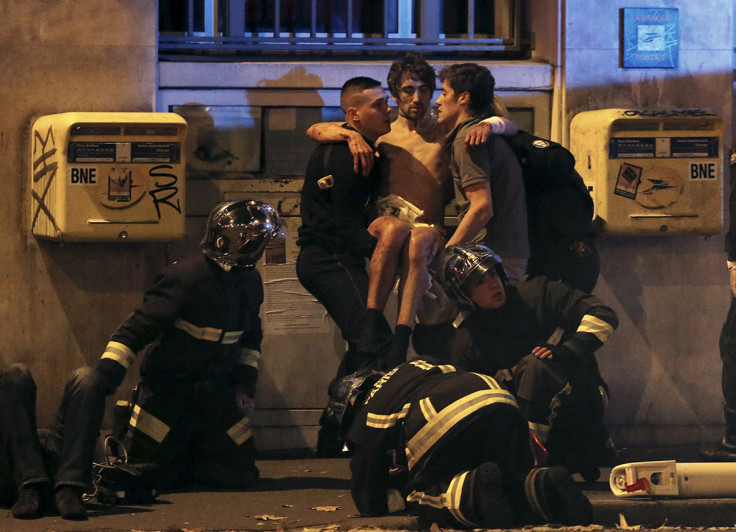
© Copyright IBTimes 2025. All rights reserved.






















